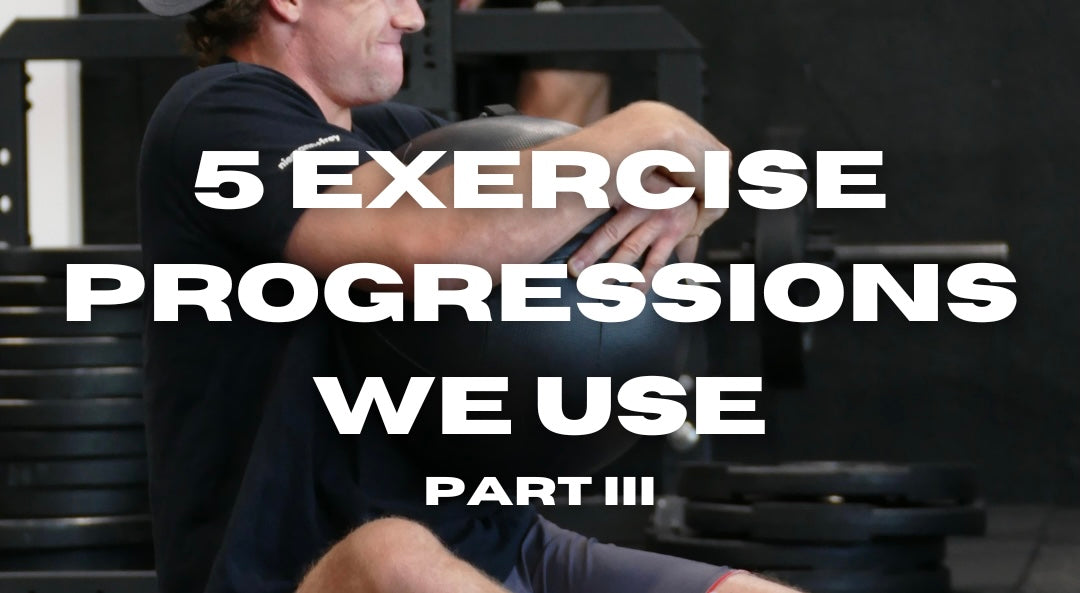
5 Exercise Progressions We Use - Part 3
Moving into our third part of this series we wanted to show this can apply into such a large variety of movements. Some within the upcoming Exercise Database Seminar we'll be layer in throughout the demonstrations of where each exercise could potentially fit. But, also where do we then move forward to after that once we have got the adaptations we needed from the first movement.

1. Hang Clean Shrugs - Hang High Pull
Olympic lifting and it's progressions go far beyond this article and one small piece of this large puzzle.
But, a simple one we tend to use with is going from this straight arm shrug variations. Teaching the individual the layer of the shoulders adding to the momentum of the lower body and having the bar travel up towards the top of the body within a clean.
With the shrug we can teach thigh contact, clean up some key points in a simple learning environment, before shifting into the high pull.
The High Pull itself being a movement of which we can load well and use to create a stimulus with athletes. Or be a bridge into the clean.

2. Natural Rebound Drop Jump - Drop Jump
With the drop jump and the ideal intent to drive minimal ground contact time. It can help to start with a movement that's driving less intent and therefor less margin for error with timing.
Allow the athlete to complete the natural rebound version of which it's more of a 'light' contact with the floor off the box before a second landing.
Starting here before moving into the drop jump means we can slowly build that stiffness upon impact, build timing, but also encourage this less rigid, robotic form of landing that's commonly obsessed over in the Strength & Conditioning world.

3. Split Stance Medicine Ball Hip Airplane - Single Leg Hip Airplane
Hip airplanes can be a great exercise for hip internal rotation as well as overall hip stability. The ability to stand on one leg and have your hip rotate around your upper leg shows great control and stability.
Simplifying it first with one of a few double leg varations of the split stance med ball hip airplane.
Having two legs on the floor with the back leg taking less load. We can widen the base of support, drop the challenge and focus on the first quality of rotate at the hip. Once we get on top of this the progression to a single leg version becomes much smoother.

4. 90/90 Hip Rotation - Medicine Ball 90/90 Hip Rotation
Athletes having both internal and external rotation of the hip provides a very important quality. Despite this movement not being the indicator of how well their hips rotate through more dynamic movements. It's a mobility entry point to build upon.
Starting with just standard 90/90s, even potentially allowing them to have their hands on the floor behind them.
Before shifting into a front loaded variation with the medicine ball which sees much more challenge of the rotation of the upper legs with less capability of that torso to lean side to side or even backwards. Driving the movement from side to side to come predominantly from the hip sockets.

5. Assisted SL DB RDL (Contralateral) - SL DB RDL (Contralateral)
We mentioned in previous articles about load vs bias and how altering where we put the load can influence different stimulus's on the body.
Here is a simple progression for the Contralateral loading. Understanding with the assisting and improving the base of support, we decrease the demand for stability through the hip.
But, by decreasing the demand of stability and having too many things going on at once to try learn upon doing this movement for the first time. We can do the assisted version, get the quality and pattern we need, then move to an unassisted version and go for the stability demand we are chasing.
For more information on education and upcoming courses, head back to our main page to find the latest.
Written by Isaac Davidson.